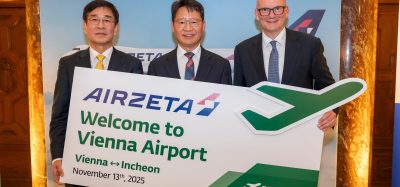Addressing connectivity, decarbonisation and regulation for the future shaping of aviation markets
Posted: 7 August 2024 | Olivier Jankovec | No comments yet
International Airport Review’s Emily Budgen, caught up with Olivier Jankovec, Director General at ACI Europe, following his speech at the ACI Europe Annual Congress, hosted by iGA Istanbul Airport.


Olivier, what a fantastic conference! Let’s start with The Connectivity Report. You talked about connectivity being empowered, when levels are compared to those of 2019, there is a gap. Can you see how this will be bridged?
I think what drives connectivity is structural changes in the aviation market. So, I think what we’re seeing is that indirect and hub connectivity is lagging, mainly because the network carriers are retrenched on the hub. They’re driven by yield maximisation rather than market share and as a result we’ve seen that indirect and hub connectivity is still some way down compared to where it was in 2019, pre-pandemic.
Conversely, direct connectivity is much closer to recovery and that reflects the increasing market share taken by ultra-low-cost carriers who’ve aggressively developed direct connectivity within the European market in terms of intra-EU routes, so there are structural changes in connectivity patterns. What can we do about it? I think, for airports, there’s not a lot we can do about it!
It reflects changing strategies from airlines. I think it’s important to consider the new aircraft coming in when we examine the future shaping of the aviation market in Europe. I mean especially the A321 Excel Air, which are perfect planes for hub bypasses. So, I think what we’re likely to see is this gap between direct connectivity, indirect and hub connectivity. It might reduce slightly, but I don’t think it’ll close. What will be interesting to watch is the advance in the next five, six, 10 years of original electric aircraft because that holds the promises of really redefining original air connectivity; it will make several very short-haul routes, which currently are not operated because there’s not the appropriate aircraft and they are not economically viable.
Join us live: Shaping the Next Generation of Hold Baggage and Air Cargo Screening
Join us live for an insightful webinar on 11th December at 14:00 GMT, in collaboration with Smiths Detection, as we explore the strategic balance of operational efficiency, regulatory compliance, and sustainability in high-volume security environments.
This session offers a focused look into future-proofing your security strategy.
Key learning points
- Cost Reduction: Strategies to minimize bag travel time while simultaneously reducing operational costs.
- Regulatory Roadmap: Insights into the next wave of regulatory changes and their impact on future investment decisions.
- Sustainable Systems: Practical approaches to building sustainability into security systems and lowering the total cost of ownership (TCO).
- Scalable Solutions: Real-world examples of scalable systems supporting current airport growth and preparing for tomorrow.
Register now for expert insights, case studies, and actionable strategies on operational efficiency!
It sounds very exciting. You mentioned earlier the advent of electric planes and new technologies. One thing I found very interesting in your speech was the focus of some airports being adapted to ‘enerports’, how there might be a blending of, or a collaboration between, two industries. Will this phenomenon be realised soon?
I think we’re at the dawn of this transformation. There’s a lot of things that need to be confirmed and there’s a lot of work to be done. We are working very closely with the rest of the industry, with Airbus through ACI. ACI is the EU Alliance for zero emission aviation, and we delivered its first vision report document which basically quantifies the number of electric and hydrogen-powered aircraft that will come into the market based on two scenarios and up to 2050. For that, this means that as airports, a critical issue will become access to grid energy in massive volumes because we will need the green energy to power those aircraft, being electricity or hydrogen. I think a clear challenge and question mark for us is how we’re going to be able to access those massive volumes of green energy.
For that we need to establish a new paradigm in our relationship, airports are no longer just about transport policy, but they are about energy policy. We need that government at EU level, at national level across Europe, to start factoring in our green energy needs within their energy policy.
That’s going to be a big part of the equation, and this vision report makes this challenge very clear. It calls for airports and government to start looking into this now because there is a very long lead time to develop energy supplies, energy infrastructure, if we want to be ready. Airbus is telling us the first hydrogen aircraft should be certified and come into service by 2035. Of course, it will take time before more airports are being deployed across the fleets of airlines, but these are master planning exercises that need to happen 20 years in advance, which means we need to start now.
There is a consensus discussion point at this conference so far, there is a need for more alignment, or desire for more alignment, in the industry from government officials and policy writers. However, that has been caveated with the need for a light touch approach. How do you think the industry and officials can find the right balance, or do you think there’s currently enough consultation?
I think it’s not easy for policy makers and regulators because there are, first, different pressures that we are facing. Policymakers and regulators tend to be much more risk-averse, and they tend to look at the past to devise the future. We see policymakers and regulators more often looking in the rear-view mirror than looking forward. I’m not necessarily criticising them, because they operate within a different constraint, a different environment, but I think the kind of challenges we are facing, especially regarding decarbonisation, need new methods of solution. Considering the way we work together as industry with the EU, there is a need for much more alignment. We need to be more consulted, more listened to, and we need to take a more recognisable part in policy and regulation. It’s not easy to achieve, but I think that’s going to be necessary if we want to address the challenge we face, decarbonising, while at the same time protecting air connectivity and its social economic benefits.
Let’s say you have a crystal ball in front of you, what is an innovation that you’d like to see or that you think is on its way?
Firstly, I’d like to make sure we have enough sustainable aviation fuel at affordable prices for the aviation sector. Secondly, I hope we will have moved to what I mentioned this morning, super-smart airports with a transformation enabled by artificial intelligence and digitalisation across the board. That will really allow us to break the operational silos between airports, airlines, ground handlers and border control, so that we can maximise efficiency and reduce investment costs as well. It’s about squeezing the assets, making the most of what we have, and because of that, potentially empower the passenger and having fewer disruptions.


C: ACI Europe.
Olivier Jankovec is Director General of the European Region of the Airports Council International (ACI EUROPE), the European region of Airports Council International (ACI). He has held the post since 2006, having initially joined in the post of Director of Strategy and Communications.
Olivier steers the association with over 30 years of governmental and lobbying experience behind him, having begun his career within the European Commission’s Air Transport Directorate as a Principle Expert before moving to Air France in Paris as Manager for European & Aeropolitical Affairs. This was followed by 5 years with Alitalia in Rome where he was Director of Institutional Relations in charge of governmental affairs at national, European and International levels.
During his tenure at the helm of ACI EUROPE, the only worldwide professional association of airport operators, Olivier has notably championed the vibrant and competitive European airport industry through the complex regulatory environment, and most recently the global pandemic. He has been instrumental in spearheading the airport industry’s leading role in aviation’s journey to decarbonisation, with ACI EUROPE launching Airport Carbon Accreditation, the global carbon management programme, in 2009 – and also being the first aviation industry body to commit its membership to Net Zero CO2 emissions by 2050 in 2019.
Join our free webinar: Revolutionising India’s travel experience through the Digi Yatra biometric programme.
Air travel is booming, and airports worldwide need to move passengers faster and more efficiently. Join the Digi Yatra Foundation and IDEMIA to discover how this groundbreaking initiative has already enabled over 60 million seamless domestic journeys using biometric identity management.
Date: 16 Dec | Time: 09:00 GMT
rEGISTER NOW TO SECURE YOUR SPOT
Can’t attend live? No worries – register to receive the recording post-event.
Related topics
Digital transformation, Emissions, Green energy, Regulation and Legislation, Sustainability, Sustainable Aviation Fuel (SAF)

















